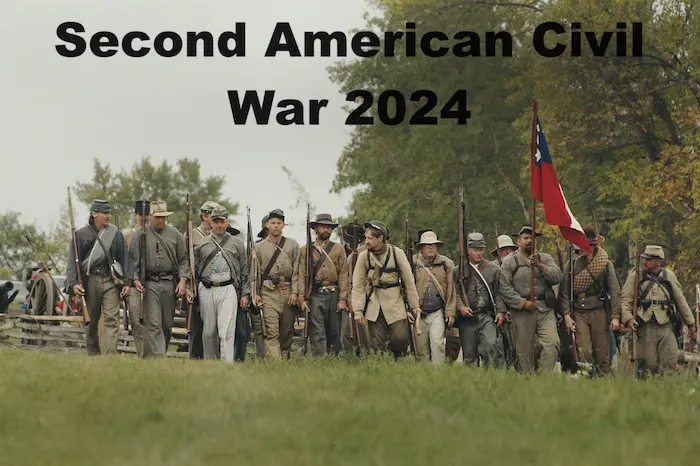The Growing Fear of the Civil War
In recent times, discussions around a potential civil war in America have intensified. Phrases like “Civil War” and “The Civil War” echo through conversations, reflecting a deep-seated anxiety about the nation’s future. A striking 43% of Americans believe a civil war is very likely within the next decade. Some, like Adam Kinzinger, a member of Congress, believe the threat is even closer, emphasizing the need for awareness and discussion.
The Reality of Civic Division
The fear of civil conflict is not limited to conspiracy theorists or fringe elements. Even respected public figures and legislators acknowledge the possibility of increased violence. Kinzinger suggests that while a traditional North-South divide is unlikely, violence could still emerge from political and social tensions. The idea of a civil war, once relegated to extreme scenarios, is now a serious concern for many.
The State of Division: A Focus Group Perspective
To understand the current mood, a corporate focus group was assembled, consisting of both conservatives and liberals who believe a civil war is a real possibility. In a hypothetical scenario of a divided America, participants were asked about their skills and preferences. The discussion revealed:
- Survival Skills: Participants with military backgrounds highlighted their combat and survival skills.
- Leadership: Some emphasized the need for leadership in times of crisis.
- Critical Thinking: Others valued strategic and critical thinking skills.
Fantasy Draft: Imagining a Divided America
In a hypothetical exercise, participants imagined dividing America into red and blue states. The discussions included:
- State Preferences: Conservatives and liberals debated which states they would want or miss.
- Constitution Drafting: Participants considered what new laws might be necessary in a divided nation. Suggestions included removing petty laws like public urination penalties.
The Likelihood of Conflict and Its Consequences
The conversation underscored a crucial point: regardless of which side “wins,” all Americans are likely to lose in a civil conflict. The consensus among focus group members was that the real victory lies in avoiding such a scenario altogether. The vision of a divided America, with new laws and potential conflicts, paints a grim picture of what could happen if tensions escalate further.
What Could the Second American Civil War Look Like?
- A Low-Intensity Conflict:
- Drawing comparisons to The Troubles in Northern Ireland, a modern U.S. civil war might involve insurgent groups engaging in underground warfare, marked by assassinations, bombings, and other atrocities. The conflict could be omnipresent yet invisible, leading to a psychological toll on those in affected areas.
- Localized Violence:
- The conflict would likely be concentrated in specific areas, with the majority of Americans only indirectly experiencing the violence through media coverage. This localized chaos could escalate into nationwide anarchy, similar to the early stages of the Syrian Civil War or La Violencia in Colombia.
- The Role of Firearms:
- With an estimated 393 million firearms in private hands, the potential for mass casualties and revenge-fueled violence is high. The abundance of weapons could turn parts of the U.S. into lawless enclaves, where survival becomes the primary concern.
How to Survive a Civil War in America
- Stay Informed:
- Keep up with reliable news sources and stay aware of any developments that could indicate an escalation of violence. Understanding the situation is the first step in ensuring your safety.
- Plan and Prepare:
- Create an emergency plan with your family, including a safe location to retreat to if violence erupts in your area. Stock up on essential supplies, including food, water, and medical kits.
- Avoid Conflict Zones:
- If possible, avoid areas where violence is likely to occur. Stay away from large gatherings, protests, or any locations that could become targets for insurgent attacks.
- Maintain Communication:
- Keep in touch with family and friends to ensure everyone is safe. Use secure communication methods and establish a network of trusted contacts.
Conclusion
While a Second American Civil War in 2024 remains an unlikely scenario, the possibility should not be dismissed. By staying informed, planning, and taking necessary precautions, you can improve your chances of surviving in the event of such a conflict.
FAQs:
What steps should I take to prepare for potential civil unrest?
Stay informed about current events and develop an emergency plan. Ensure you have essential supplies and a safe location to retreat to if needed.
Is a Second American Civil War likely in 2024?
The likelihood is low, but the warning signs are present. It’s essential to stay informed and prepared.
What should I do to prepare for a civil war?
Create an emergency plan, stock up on supplies, and stay informed about the situation.
How can I stay safe during a civil war?
Avoid conflict zones, maintain communication with loved ones, and follow your emergency plan.
How can I protect myself and my family during a time of political violence?
Avoid areas known for protests or violence. Keep open communication with family members and establish a plan for staying together during emergencies.







Question: “How can one prepare for a civil war in terms of food and supplies without causing panic or overpreparing?”
Author “Balancing preparation and calmness is vital. Start by stocking essentials slowly and discretely to avoid alarm.”
“I never thought I’d live through such uncertainty. Learning basic survival skills and preparation saved my family during chaos.”
Stay informed, stock up on essentials, create a safety plan with loved ones, and monitor reliable sources for updates.
Engaging content exploring the growing concerns and realities of potential civil unrest, though more practical survival tips could enhance value.
How can individuals prepare for a potential civil war? Is stocking up on supplies enough?
Author Preparing for survival goes beyond supplies. Building community connections and having a safety plan are crucial.
Stay informed on emergency preparedness plans in your area and establish communication channels for safety during civil unrest.
Comment: “How can one prepare for a civil war without inciting panic or worsening the situation inadvertently?”
Author Reply: “Balancing preparedness and caution in discussions, focusing on unity and de-escalation can help minimize tensions and potential conflict.”
This post effectively captures the heightened concerns surrounding a potential civil war in America, emphasizing the urgency for awareness and dialogue.
Question: Is there evidence to suggest that daily routines or living locations could affect survival odds in a civil war scenario?
Author Reply: Yes, research indicates that urban areas face higher risks due to population density and resource scarcity.
Comment: How can we be sure this won’t incite unnecessary panic instead of fostering dialogue and understanding?
Author Reply: Understanding potential threats can lead to preparedness without promoting unnecessary fear. Let’s approach this topic with caution.
This insightful post delves into the unsettling possibility of a second American Civil War, urging preparedness and dialogue for uncertain times.
Doubt Comment: How can we prepare for a civil war without inciting panic or contributing to the division?
Author Reply: Preparation involves staying informed, fostering dialogue, and promoting unity to prevent escalating tensions in communities.
In times of civic division, focusing on community resilience, emergency preparedness, and de-escalation skills can foster unity and safety.
Comment: How can we be sure this isn’t just fear-mongering? Is there concrete evidence for this imminent threat?
Author’s Reply: Our article aims to address legitimate concerns based on rising political polarization and historical precedents.
Question: How can we prepare our children for the possibility of a civil war without instilling fear and anxiety in them?
Reply: Educate them on history, democracy, and conflict resolution while emphasizing safety measures and fostering open communication.
This blog post sheds light on the concerning possibility of a civil war in America, urging readers to prepare and stay informed.
The post offers a timely exploration of escalating fears and crucial discussions around a potential civil war in America.